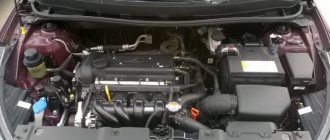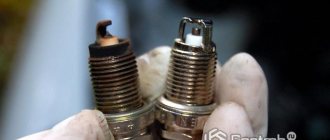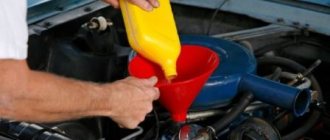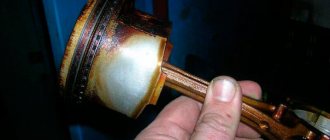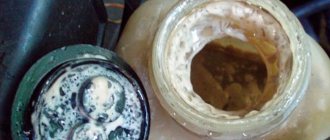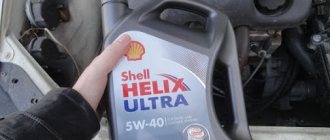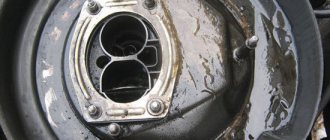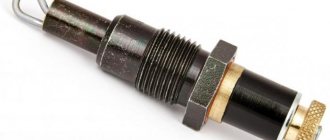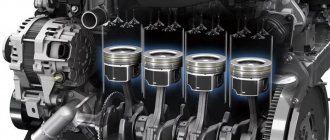As you know, experts and experienced car enthusiasts recommend checking the oil level at least once a week. Let us immediately note that there are quite good reasons for this. Also, regular checks allow not only to promptly detect a decrease in the level of lubricant in the engine, but also to assess the form and condition of the lubricant.
In other words, even if the oil level does not significantly deviate from the norm, but there is a noticeable change in the color, consistency or smell of the lubricant, then such signs clearly indicate the need for diagnostics of the internal combustion engine.
In this article, we will look at a situation where, during an inspection, it was discovered that the engine oil smells like gasoline, gasoline is clearly noticeable in the engine oil, the reasons for this phenomenon and ways to solve this problem.
Reasons requiring specialist intervention
The most unpleasant reason for gasoline getting into the oil of an engine with an injector is a malfunction of the piston group. The cylinder walls may be deformed, cracked, scratched or chipped. With prolonged use of oil with poor cleaning properties, the oil scraper rings become coked.
A breakdown is determined by measuring the compression in each cylinder. Measurements may differ from each other by one unit. If there is a larger gap in the compression values, we can talk about a malfunction in the specified cylinder. In such a situation, it is impossible to do without a major engine overhaul.
You can try to restore coked oil scraper rings using special chemicals, but such manipulations do not always produce a good effect.
Let's sum it up
The reasons for gasoline getting into the engine lubricant of a car equipped with an injector are as follows:
- Ignition system malfunction
- Worn injector nozzles.
- Malfunction of the fuel pump.
- Occurrence, coking of oil scraper rings.
- Piston system malfunction.
- Use of low-quality fuel.
The last reason is the most insidious. Gasoline is an aggressive chemical mixture with a certain amount of various additives, which should not come into contact with the engine oil of cars equipped with an injector: it can change the properties of the lubricant, destroy its structure - this will lead to drive failure. If you notice an admixture of gasoline in the engine fluid, eliminate the cause of this situation, then replace the engine mixture.
Checking and repairing a mechanical fuel pump at home
It is advisable to begin any repair work on the engine by washing and cleaning dirt and dust at least at the repair site. The fuel pump must be removed by unscrewing the two mounting bolts. It is better not to disconnect the inlet and outlet gas pipelines if they do not interfere with dismantling. Otherwise, they can be disconnected by plugging the incoming fuel line with a plug of the appropriate size, otherwise fuel will leak from it.
After removal, put the fuel lines onto the fittings and secure them with clamps. The outgoing gas line must be clamped with a clamp if it is rubber. If the tube is metal, disconnect it from the carburetor and plug it tightly with a suitable plug. Then try to pump gasoline into the engine using the manual pumping lever. If on the side adjacent to the engine housing there are streaks of gasoline in the oil or a clearly and sharply distinct smell of fuel appears, it means that the fuel pump diaphragm is not sealed.
Further actions are possible in two options: replace the fuel pump with a similar new one or repair the existing one. When repairing an already installed device, you must purchase a repair kit for the device model being repaired. As a temporary option, you can add a couple of layers of cellophane to the diaphragm, but this will not last long. Disassembly and assembly of the fuel pump must be carried out in accordance with the vehicle manual.
If you have a set of spare parts for repair, it is advisable to replace all existing parts, especially the intake and exhaust valves and their springs. Wash the filter mesh thoroughly in clean gasoline or solvent. After assembly, it is advisable to check the functionality of the device and the tightness of the diaphragm. Checking this part is described above.
We recommend: Preparing a car for sale: how to clean the car interior
You can check its functionality by disconnecting the outgoing gas line from the carburetor or pump and pumping it with a lever. A full stream of fuel should splash out of the hose or fitting with each press. After completing all repair work, you need to more carefully monitor the oil, its level and color for some time during operation to be completely sure that the problem has been eliminated.
How to diagnose gasoline getting into oil
The presence of gasoline in the engine lubricant can be determined in a simple way. Place the dipstick with a layer of oil into the flame of a lighter or match, while observing safety precautions. It is better to do this in the fresh air, at a distance of 2-3 meters from the car. Oil without foreign impurities almost does not burn on its own. If a certain proportion of gasoline is present in it, a bright flash will appear on the dipstick.
We recommend: Why does the car periodically stall while driving?
If there is water or liquid in the oil from the cooling system, sparks, splashes and crackles are formed, like sunflower oil in a frying pan. If the test results show gasoline in the oil or liquid from the cooling system, it is worth remembering and evaluating the behavior of the engine recently. The main criteria for correctly determining the reason why gasoline is present in the oil are:
- increased fuel consumption;
- engine power: how it starts, picks up speed, how it pulls up hills;
- extraneous noise and knocking in the piston block;
- oil level in the engine sump and its color;
- coolant level.
To solve the problem of gasoline getting into the oil, a compression gauge is used
If any of these signs are present, it is advisable to contact specialists from a car service center. If for some reason the help of auto repair companies is excluded, you can try to figure it out yourself. Gasoline can get into the oil mainly due to a malfunction of the mechanical fuel pump on carburetor engines, malfunction of the injectors on injection engines and a malfunction of the piston system on all types of engines. To work you must have the following tools and devices:
- compression gauge;
- pressure gauge with a special fitting for measuring pressure in the fuel system;
- a set of keys, screwdrivers, etc.;
- multimeter or similar measuring device;
- rags, liquid for removing dirt and washing components;
- liquid for decoking the piston system (if necessary).
Injection nozzles
In an engine with injectors, the smell of gasoline coming from the dipstick indicates a breakdown of the injectors and ignition system. In the first case, we are talking about the fact that the injectors lose proper tightness. After turning off the engine, fuel, due to residual pressure, seeps into the manifold and from there penetrates the cylinder block. The piston rings serve as a barrier to the crankcase, but if they are worn out, gasoline will still get there.
There is also a smell of gasoline if the ignition system is faulty. If a spark plug breaks, the fuel does not ignite in the cylinder block, that is, it is simply wasted. To fix the problem, you need to remove the fuel rail and check the tightness of all injectors one by one by supplying them with kerosene under pressure. Leaking parts and broken spark plugs need to be replaced with new ones.
Poor quality fuel
Poor quality fuel is one of the reasons for mixing gasoline and oil in the crankcase.
Another reason why it is believed that gasoline fluid can penetrate the crankcase is the poor quality of the oil in the crankcase itself. The fact is that the gasoline sold is often of very low quality.
The buyer will often purchase fuel mixed with additives, which by their nature are already harmful compounds. We are talking about benzene, toluene, etc. They can get into the crankcase with an oil element much faster than high-quality fuel. Manufacturers, in pursuit of fabulous profits, began to create new additives and mix what should not be mixed.
Oil that has been exposed to low-quality fuel can quickly lose its performance properties. This will lead to damage to the fuel distribution mechanism. A technical malfunction may not necessarily be related to a defective diaphragm or carburetor. Often the cause is simply poor quality fuel.
Therefore, in order to neutralize the problem in some cases, you just need to change the fuel itself. You also need to be more careful when choosing fuel if there are signs that a surrogate is being poured into the car. You need to immediately change this brand of fuel to another. This happens quite often, since the quality of fuels and lubricants is often called into question.
Causes
If the engine oil smells like gasoline, there is definitely a malfunction in the engine, due to which fuel penetrates the car’s lubrication system. Under no circumstances will the oil itself emit a fuel odor.
There may be several reasons for the appearance of a gasoline smell in oil.
- Malfunction of the engine power supply system. On carburetor engines, improper adjustment of the carburetor needle and choke can lead to excessive fuel supply to the engine. Malfunctions of the injectors will also lead to overflow. During the power stroke, only a certain amount of gasoline can burn in the cylinder (a proportion equal to the stoichiometric ratio). The unburned part of the fuel partially flies out into the exhaust manifold, and partially seeps through the piston rings into the crankcase. Long-term driving with such a breakdown leads to the accumulation of gasoline in the cylinders and the appearance of a characteristic odor.
- Misfires. Faulty spark plugs, malfunction of the ignition timing mechanism, broken high-voltage wires, wear of the distributor - all this leads to periodic misfire of gasoline. Fuel that is not burned during the power stroke partially enters the crankcase.
- Wear of the cylinder-piston group. During the compression stroke, if the cylinders and piston rings are severely worn, the fuel-air mixture enters the crankcase. Gasoline condenses on the walls of the crankcase and flows into the oil. This malfunction is characterized by low compression in the cylinders. However, with this breakdown, the process of enriching the oil with gasoline proceeds slowly. And the gasoline has time to evaporate and exit through the breather. Only in case of critical wear will a sufficiently large amount of fuel penetrate into the oil in order to smell gasoline on the dipstick or from under the oil filler neck.
We recommend: We remove the vacuum brake booster on a VAZ-2110 with our own hands for replacement
Pay attention to the oil level on the dipstick. The problem becomes serious if, in addition to the smell, there is an increase in the oil level. In this case, it is necessary to eliminate the cause of the malfunction as quickly as possible.
Consequences of operating a car with damaged oil
The properties of motor lubricant are disrupted when mixed with fuel. Viscosity decreases, the effect of additives is neutralized. Working parts are subject to early wear.
Using spoiled fuel and lubricants leads to the following problems:
- The operation of the crankshaft is disrupted. Early wear of the bearings and the formation of scoring lead to jamming of the engine.
- The piston system falls apart as a result of deposit accumulation and detonation of the fuel mixture.
- Exhaust valves are destroyed. Deposits impair the sealing of connections. Combustion of the mixture damages parts.
- Wear of piston rings and cylinders is a consequence of exposure to high temperatures.
In such a situation, wear of the mechanisms quickly occurs, which will lead to engine failure.
Fuel consumption during vehicle operation increases. Detonation of the fuel mixture increases the risk of fire.
Attention to the running engine and timely detection of fuel leaks preserve operational properties and save from the development of dangerous situations.
We independently find and eliminate the causes of breakdowns
The presence of fuel in the engine fluid can be judged by the smell of the oil taken from the dipstick; it begins to smell like fuel. The reason for this is the disruption of the operation of such nodes:
- Ignition systems. If one of the spark plugs stops working, the air-fuel mixture supplied to the cylinder does not ignite and does not perform useful work; part of the gasoline settles on the cylinder, then flows to the crankcase, and a corresponding unpleasant odor appears. To eliminate this cause, check each of the spark plugs.
- Injector nozzles. If the injectors do not close tightly, then when the engine stops, a certain amount of fuel with the help of residual pressure reaches the manifold, then to the cylinders. The breakdown can be eliminated by checking the injectors for leaks by supplying injector cleaning liquid from a can into them. Replace leaking injectors.
- Electric pump. With its help, fuel is pumped. If the pump malfunctions, the fuel pressure in the system is very low - the injectors do not spray gasoline, but pour it. Poor atomization leads to poor mixing of fuel with air, which causes poor combustion, due to which gasoline does not burn completely and some of it leaks through the rings into the oil. Inspect the pump gaskets; if they are mechanically damaged, cracks, replace the gaskets with new ones.
Unscrupulous fuel manufacturers, wanting to save money, add low-quality additives to gasoline to increase the octane number. This way they increase their profits. The use of this fuel leads to deterioration in the performance of the spark plugs and electric pump. Inspect the spark plugs; a red coating on them means that low-quality fuel has been filled.
The smell of gasoline in engine oil, where does it come from?
If the engine is an injection engine, then the breakdown of the fuel pump disappears immediately. The engine simply wouldn’t start without it. But injectors can indeed freeze, especially if the gasoline contains water. You can check the cause of burnt-out rings yourself - it will be enough to measure the compression.
Even the dipstick shouldn't smell like gasoline.
The first step is always to look at candles. If black carbon is present, the cause will be one of two things: either the mixture is too rich or it is misfiring. Try to distinguish the first from the second: if the engine “troubles”, you can hear it. In addition, the error with omissions must be diagnosed by the ECU - the Check lamp lights up.
The same thing, but in order
Let's say the Check light really came on. Then we look for error 0300 , 0301-0304 or 1301-1304 .
And then the ignition is diagnosed - we need to look for the cause of the problem, and not just change the spark plug.
Two candles, normal and carbonated
If all the candles are burned equally, then the reason will most likely be a malfunction of the injectors. They can “freeze”: the valve travel will be limited by ice, which always melts as it warms up. Advice - in this case, change the gas station.
Cleaning nozzles and clogging filters - all this does not apply to our case. Here, on the contrary, the mixture turns out to be too rich.
There are known cases when the nozzle did not close completely, but then the engine should smoke... There is nothing wrong with that, by the way - it will start smoking and stop. But the oil will have time to become saturated with harmful fumes.
Engine oil doesn't just smell like gasoline. We need to look for the cause by checking the ignition system and injectors.
Compression as a cause of gasoline smell?
It is unlikely that the compression rings, but not the oil scraper rings, burn out.
Three different rings on the piston
Therefore, it makes sense to perform an initial diagnosis:
- The smell of gasoline may be present in the engine oil, but the oil itself is not consumed or even “arrives.” Conclusion: the rings are not burned out, there is no need to check the compression.
- If both factors are present, that is, the smell of gasoline and oil consumption, then it is too late to take any measurements - burnt-out rings are already making themselves felt.
Nevertheless, in order to assess the level of the problem, in case 2 measurements are taken - a strong deviation from the norm will be detected.
If the deviation does not exceed 5-10%!, you don’t have to think about any burnout of the rings. Example: 14.2-15-15.4-15. This is still the “norm”.
It turns out that the initial conclusion is not drawn from the measurement results, but only from observations of the oil level.
Compression test, Nissan Almera
By the way, we considered only injection engines, but not carburetor engines or engines with direct injection.
Malfunctions and checking of injectors of the injection power system
If one or more injectors do not close completely, fuel may leak into the cylinder and through the piston clearances into the oil. First, you can check the pressure in the power system. To do this, you need to get a pressure gauge with a rubber hose for high pressure and an adapter for connecting to the fuel rail. The upper limit of the pressure measured by the pressure gauge must be at least 6 kgf/cm².
The adapter must be connected to the ramp, the pressure gauge must be connected to the adapter. Then you need to turn on the ignition. If the fuel pump starts, wait until normal pressure rises in the rail. Then turn off the ignition. If the fuel pump does not start when the ignition is turned on (this is not a malfunction), start the engine, check that the pressure rises to the nominal value, turn off the engine and turn off the ignition.
We recommend: Signs of a faulty fuel pressure regulator
You need to observe the pressure gauge readings for 5-10 minutes. If the instrument needle has moved downward by more than a third (example: the nominal pressure was 3 kgf/cm², after stopping it dropped to 2 kgf/cm²), you should look for a leak in the fuel supply system. Next, you need to remove the fuel rail with injectors and place it in a place accessible for inspection.
Injectors that are not completely closed can cause fuel to enter the lubricant.
Each of the nozzles should be placed in a transparent container; you can use plastic glasses with a volume of 0.5 liters. Fuel lines and electrical connections must be connected. Then you also need to turn on the ignition and, if necessary, crank the engine with the starter.
While scrolling, you can visually check the operation of the injectors by the type of fuel being sprayed. Having reached the optimal pressure in the power system, you need to turn off the ignition and visually check each of the injectors for gasoline leakage through the nozzle. If you detect leakage on one or more injectors, you can measure the resistance of the windings with a tester.
If the measured resistance value differs from the nominal value (usually 10-15 Ohms), the injector is leaking, or the spray pattern is different from others, then the injector must be replaced in accordance with the vehicle manual. After completing the repair, it is also necessary to check the oil for a certain period of operation.
What are the dangers of mixing fuel with lubricant?
When gasoline gets into the engine oil, it triggers complex reactions that ultimately lead to various breakdowns. It should be added that everything depends on the volume of fuel that is in the engine oil. If it is small, the motor will work normally for a little longer. However, serious problems will still appear. If there is a large amount of gasoline in the crankcase, this quickly leads to car breakdowns.
Consequences of gasoline penetration into oil:
- violation of the fuel correction coefficient. The power unit sometimes cannot be started;
- decreased driving speed, the car has difficulty reaching maximum speed;
- piston failures occur;
- engine failure. This happens when the carburetor or injectors are damaged.
How can you tell if your car has a problem? You need to pay attention to certain signs:
- increased fuel costs. Gasoline is consumed quickly due to the fact that some of it flows into the engine for lubrication;
- strong knocking, noise in the piston system. This is evidence that fuel processing is disrupted;
- engine power decreases, making it more difficult for the car to drive up hills;
- the color of the oil changes;
- The coolant level drops.
What to do if you notice one of the above signs? Go to a car service immediately.
Common problems
The main reason why car oil comes into contact with fuel is severe wear of the compression/oil rings. Gasoline flows into the crankcase, oil enters the combustion chamber. All this indicates that the power unit needs to be overhauled, since it has accumulated many serious faults.
The engine becomes much weaker if the compression of at least one cylinder decreases. Excess fuel in the combustion chamber also does not lead to anything good. Carbon deposits will increase and the engine will constantly overheat. Consequently, the viscosity of the automotive lubricant will change. In other words, the oil will begin to thin out. This is unsafe for an engine operating at high speeds under harsh operating conditions.
The consequences of any malfunction can be minimized if the problem is detected in time. You need to pay attention to the above signs of a leak. Then you won’t have to go to a car service center to have your car’s engine completely repaired. This service is quite expensive, so it is better to know what the main signs of fuel getting into the oil liquid are. This will make it possible to avoid many significant financial expenses.
Signs of a leak ↑
The driver can know that a leak has occurred by seeing a black puddle under the car. Oil may leak from the valve cover gasket, damaged oil seals, or damaged crankcase gasket. When leaking into the external environment, oil, as a rule, does not mix with other motor fluids. The oil/gasoline mixture can only form inside the engine and only under certain circumstances. Cases when motor oil gets into the fuel also occur outside the car, for example at a gas station or due to the negligence of the owner who mixed up the canisters. It is unrealistic to separate these substances in a garage, and pouring such a mixture into the tank (except for two-stroke engines) is strongly not recommended. You can notice that there is a significant amount of fuel in the lubricant by other signs:
- the consistency of the lubricant has changed, it has become more liquid;
- the grease on the dipstick flashes when ignited with a match;
- a drop of grease on paper leaves a greasy, expanding halo around itself, which quickly evaporates.
If these signs are present, then it’s time to visit a car service center.
The rule of looking under the hood of a car at least once a week and checking the level and condition of lubricant, brake fluid and antifreeze will be a good habit for any driver, regardless of the make of the car. Detecting a leak early will save time and money.
